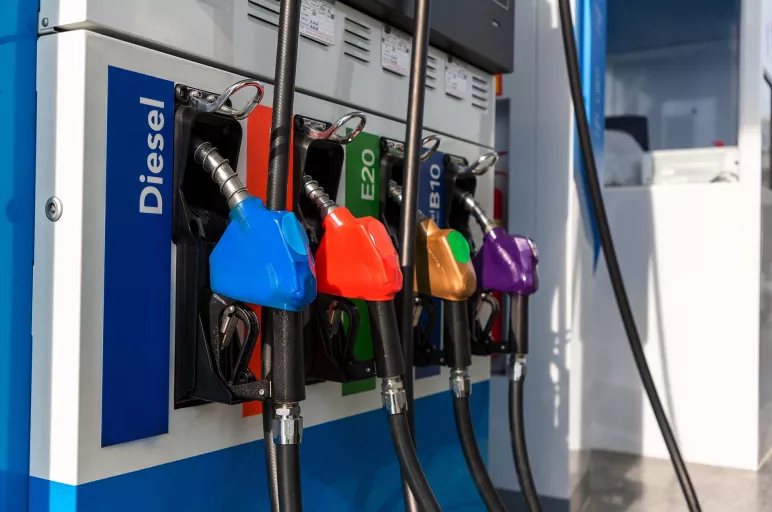
The Rise of Renewable Diesel: Opportunities and Challenges
- Renewable diesel reduces carbon emission in diesel engine exhaust by 50-80%
- Rising renewable diesel demand is increasing the cost of feedstocks such as soyabean oil and animal tallow, impacting refiners
- Asia-Pacific’s decarbonization efforts are likely to determine the scale of adoption of renewable diesel
March 11, 2022 | Oil and Gas 4 minutes read
The renewable diesel industry is set to grow with fuel refiners looking for alternative growth paths in a low-carbon world.
As of 2020, 5.5 billion liters of renewable diesel were being produced globally from soyabean oil, animal fat waste and used vegetable oil from restaurants, and materials such as wood chips, sawdust, switchgrass and crops residue.
The process of extracting renewable diesel is similar to the hydrotreating process used for conventional petroleum diesel and is also chemically identical to conventional diesel, comprising of straight-chain and branched paraffin with typical carbon numbers of C15–C18.
However, unlike petroleum diesel, renewable diesel is odorless and colorless.
How renewable diesel is produced
Renewable diesel undergoes hydrotreating, thermal conversion, or biomass-to-liquid production processes, making it chemically identical to ultra-low sulfur diesel (ULSD) and an ideal replacement for all current diesel engines.
In the standalone production method, the global market expects the usage of Fischer-Tropsch or the fast pyrolysis process to produce low-carbon diesel and jet fuel.
Also, in the co-processing method, vegetable oils are added with petroleum to distillate together in refinery units such as hydrotreaters. Examples include Preem in Gothenburg, Sweden, with 0.2 million tons/year production, Petrobras in Brazil, Repsol in Spain and BP in Australia.
The benefits of using renewable diesel
- Renewable diesel significantly reduces greenhouse gas emissions, along with an 80% lifecycle reduction in gases, and a reduction in carbon emission in diesel engine exhaust by as much as 50-80%, compared to conventional diesel.
- By using a minimum 14% of renewable energy in road and rail transport by 2030, renewable diesel is expected to be used as an alternative for refineries to meet Europe’s renewable energy directive-II (RED-II) goals (2018).
- Investment in renewable diesel can help expand other renewable fuel industries such as gasoline, naphtha and Sustainable Aviation Fuel (SAF), since they use similar infrastructure and technology.
- Since this diesel meets the ASTM international specifications, it can be processed in existing storage tanks and pipelines.
- It can power conventional auto engines, making it a low-pollution and profitable option.
- Use of renewable diesel allows countries to join the circular energy transition without making huge expenses to replace existing infrastructure.
Outlook on the renewable diesel market
Low-carbon fuel mandates globally, and increasingly stringent greenhouse gas standards being rolled out in the European Union, are increasing the demand for renewable diesel.
According to the U.S. Energy Information Administration, by 2025, North America’s renewable diesel production capacity is expected to increase 5 times, to about 63 million barrels, indicating significant supply expansion and investment in renewable diesel plants in the U.S. and E.U. to meet the doubling of renewable diesel consumption.
Southeast Asia, Australia, Indonesia and Singapore are leading the initiatives to transform the renewables market by setting more aggressive renewable fuel targets. Indonesia, the world’s largest palm-oil producer, intends to leverage new and existing petroleum refineries to turn palm oil into biodiesel.
The boom is expected to impact agriculture by increasing the demand for oilseeds like soyabean and canola, driving up food prices. To address issues of feedstock supply that could emerge, canola is now being seen as a promising new feedstock in addition to the mix.
As suppliers look to assess the availability of sufficient feedstocks in the future, renewable diesel is expected to only see mainstream consumption dependent on how renewable fuel policies shape up in different countries. Hence global regulations are expected to play a vital role in its development.
Fleet managers too have been seeing nearly effortless switchovers to renewable diesel. The world is also expected to gain better cost efficiency as large corporations like Amazon and Walmart lead the way in integrating renewable diesel into their fleets.
Moreover, increased demand for sustainable road and air transport (due to severe measures taken by the airlines industry towards decarbonization), and chemical and polymer products will drive the growth of renewable diesel.
For now, renewable diesel prices are expected to increase the cost slightly more compared to conventional fuel. Refiners too are expected to continue relying on soyabean oil as a carbon – intense feedstock.
However, with increased competition between different fuel supplies, the cost of this alternative is expected to level out.
The challenges
- Rising renewable diesel demand is causing an increase in cost of feedstocks such as soyabean oil and animal tallow, thus impacting refiners. The increased demand is also expected to impact the usage of land and increase food prices.
- Renewable diesel does not have the high energy density of ULSD
- Developing new logistics systems to supply the waste feedstocks to capable refineries.
- The shortage of raw materials required to accelerate fuel production also acting as a constraint for the industry.
- Meeting global demand forecasts would require diverting raw materials from traditional biodiesel production toward renewable diesel production.
Currently, renewable fuels contribute a fraction of the overall global sales of conventional fuels.
However, as Asia-Pacific contributes half of the world’s carbon emissions, decarbonization efforts in this region are likely to determine the scale of adoption of renewable diesel in the near-future.
Author: Pranav Bhat



